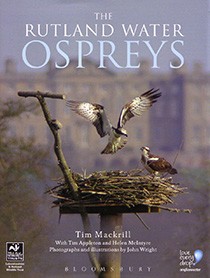The Rutland Water Ospreys by Tim Mackrill

The book reveals that introducing Ospreys to Rutland Water involved far more than collecting some young birds in Scotland and releasing them in Rutland. There was paperwork, planning, and adapting to the inevitable hiccups that the first year presented — this was, after all, the first time a project like this had been attempted with Ospreys in Europe. It explains how the team had to deal and adapt to changes in their plans; the criteria used to select a chick for translocation from Scotland; the site of the release pens; and the challenge of feeding the birds with minimal disturbance.
The book starts with several chapters written by different people involved in the Osprey reintroduction (though you will need to check back to the contents page to see exactly who it is writing what); it first describes the early years, from the set-up of the project to the first introductions, the first returning birds, the critical first breeding, and the end of the translocation phase in 2002. The remainder of the first half of the book consists of a chapter for each of the following years, from 2003 right up to 2012. The number of man-hours and the work that has gone into this project from all parties involved is quite staggering: hours spent watching the nests from hides — or the back of a leaky Land Rover; monitoring and ringing chicks; building (and rebuilding) nests.
The second half of the book shifts away slightly from the core of the project. The legacy of the Rutland Ospreys is notable: not just the tourists they have brought to the Rutland area or the inspiration they have provided to local communities — nowhere is this more evident in the book than in the handful of one-page 'Volunteer Diaries' that appear between chapters — but it extends far wider than Rutland. British Ospreys, Rutland birds included, leave the British Isles for the winter, all heading south, with most wintering along the West African coast south of the Sahara. Satellite tracking has given a unique insight into the route taken by Rutland Ospreys and the hazards they face en route, while this link between Rutland and Africa has provided the opportunity for the team to educate school pupils in The Gambia about the Ospreys' amazing annual journey: education that will hopefully lead to conservation. The Rutland Osprey project has been exported slightly closer to home, too: to Italy, in the form of expertise, where the Rutland team helped with establishing a breeding colony of Ospreys; and to Wales, where Rutland birds themselves have settled to breed.
The book has a scrapbook feel to it, with plenty of photographs and illustrations throughout. I've been following John Wright's blog, and admiring his amazing artwork, for some time, and it's a real pleasure to see his sketches and studies printed in this book.
The Rutland Water Ospreys is a beautiful publication and a fascinating read. For anyone who's ever experienced the joy of observing Ospreys in southern Britain — be it one of the Rutland birds raising a family in Wales or an early-morning cruise on the Rutland Belle — and wanted to know a bit more about them, this book is a must-read.
The Rutland Ospreys by Tim Mackrill, with Tim Appleton and Helen McIntyre.
Hardback, 160pp.
Bloomsbury (2013), ISBN 978-1-4081-7414-2, RRP: £20.00
Colour photographs and illustrations throughout.


